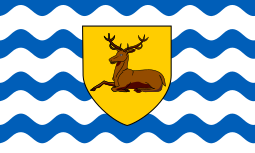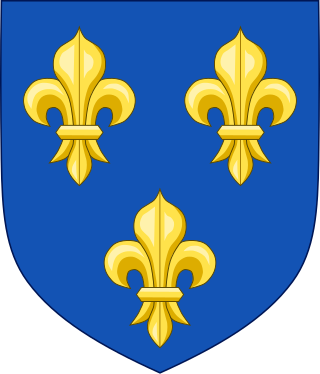
The fleur-de-lis, also spelled fleur-de-lys, is a common heraldic charge in the shape of a lily. Most notably, the fleur-de-lis is depicted on the traditional coat of arms of France that was used from the High Middle Ages until the French Revolution in 1792, and then again in brief periods in the 19th century. This design still represents France and the House of Bourbon in the form of marshalling in the arms of Spain, Quebec and Canada, for example.

The flag of Scotland is the national flag of Scotland, which consists of a white saltire defacing a blue field. The Saltire, rather than the Royal Standard of Scotland, is the correct flag for all private individuals and corporate bodies to fly. It is also, where possible, flown from Scottish Government buildings every day from 8:00 am until sunset, with certain exceptions.

A saltire, also called Saint Andrew's Cross or the crux decussata, is a heraldic symbol in the form of a diagonal cross. The word comes from the Middle French sautoir, Medieval Latin saltatoria ("stirrup").

The flag of the state of Maryland is the 17th-century heraldic banner of arms of Cecil, 2nd Baron Baltimore. It consists of the arms of his father George, 1st Baron Baltimore (1579–1632), quartered with those of his grandmother, heiress of the Crossland family. The flag was officially adopted by the General Assembly of Maryland in 1904.
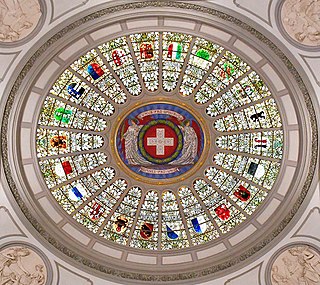
Each of the 26 modern cantons of Switzerland has an official flag and a coat of arms. The history of development of these designs spans the 13th to the 20th centuries.
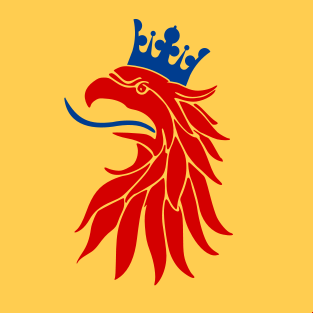
Flag of Scania refers to two different flags, of which one is a banner of the provincial coat of arms featuring a griffin head, and the other is a flag with a Scandinavian cross, the Scanian Cross Flag. They both are used as a provincial flag representing Scania, the southernmost province of Sweden.

The coat of arms of Ireland is blazoned as Azure a harp Or, stringed Argent. These arms have long been Ireland's heraldic emblem. References to them as being the arms of the king of Ireland can be found as early as the 13th century. These arms were adopted by Henry VIII of England when he ended the period of Lordship of Ireland and declared Ireland to be a kingdom again in 1541. When the crowns of England, Scotland and Ireland were united in 1603, they were integrated into the unified royal coat of arms of kingdoms of England, Scotland and Ireland. The harp was adopted as the emblem of the Irish Free State when it separated from the United Kingdom in 1922. They were registered as the arms of Ireland with the Chief Herald of Ireland on 9 November 1945.

The Ulster Banner, also unofficially known as the Ulster Flag or Flag of Northern Ireland, is a heraldic banner taken from the former coat of arms of Northern Ireland, consisting of a red cross on a white field, upon which is a crowned six-pointed star with a red hand in the centre. It was the flag of the former Government of Northern Ireland and common flag of Northern Ireland from 1953 until that government was abolished in 1973 with the passing of the Northern Ireland Constitution Act 1973.

The Saint Alban's Cross is a yellow saltire on a blue field. It is found in several flags, notably that of the Cathedral and Abbey Church of St Alban, previously a Benedictine monastery, and the city of St Albans, Hertfordshire.
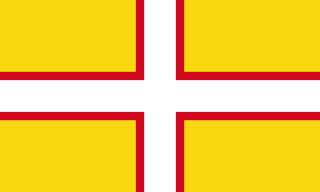
The flag of Dorset is the flag of the English county of Dorset. It was chosen as the flag of Dorset on 16 September 2008 following a vote open to all Dorset residents, and organised by Dorset County Council. The unitary authorities of Bournemouth and Poole declined an invitation to participate. The flag has subsequently been registered at the Flag Institute and added to their UK Flags Register.
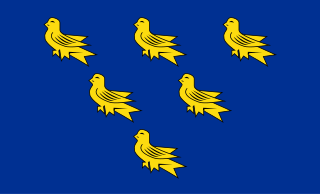
The Flag of Sussex is the flag of the traditional and historic county of Sussex. The flag was registered by the Flag Institute on Friday 20 May 2011 as a 'traditional' county flag as a result of a campaign started in August 2010, by Sussex resident Brady Ells, with support from his father, David. The Flag was certified by Chief Vexillologist, Graham Bartram. It was first flown officially on Saturday 28 May 2011 at Lewes Castle. and was flown from the Department of Communities and Local Government at Eland House, London on Sussex Day, 16 June 2011.

The flag of Somerset is the flag of the English county of Somerset. A campaign had been running between 2006 and 2009 in support of a flag and subsequently the Association of British Counties had taken up the campaign. The Lord Lieutenant of Somerset, Elizabeth, Lady Gass, had shown her support as had David Heath MP and the local TV, radio and newspapers. The flag was adopted following a competition in July 2013. This symbol was mentioned in the book "The Once and Future King" by T.H. White, and is said to have been worn by Arthur during the first joust of Lancelot and Arthur.

The royal standards of England were narrow, tapering swallow-tailed heraldic flags, of considerable length, used mainly for mustering troops in battle, in pageants and at funerals, by the monarchs of England. In high favour during the Tudor period, the Royal English Standard was a flag that was of a separate design and purpose to the Royal Banner. It featured St George's Cross at its head, followed by a number of heraldic devices, a supporter, badges or crests, with a motto—but it did not bear a coat of arms. The Royal Standard changed its composition frequently from reign to reign, but retained the motto Dieu et mon droit, meaning God and my right; which was divided into two bands: Dieu et mon and Droyt.

The Northumberland flag is the flag of the historic county of Northumberland and the banner of arms for Northumberland County Council. The shield of arms is in turn based on the arms medieval heralds had attributed to the Kingdom of Bernicia. The Bernician arms were fictional but inspired by Bede's brief description of a flag used on the tomb of St Oswald in the 7th century.

The Shropshire flag is the county flag of Shropshire. It was registered with the Flag Institute in March 2012 and officially became the county's flag on 19 April 2013.

The Bedfordshire flag is the flag of the English county of Bedfordshire. It is based on the banner of the arms of the former Bedfordshire County Council, which was granted the arms in 1951 by the College of Arms. This design was adopted as the flag of the historic county in September 2014, with the support of the High Sheriff of the county.

The flag of Surrey is the blue and gold chequered flag of the traditional county of Surrey and is derived from the coat of arms of William de Warenne, 1st Earl of Surrey.

The East Lothian flag is the flag of the Scottish county of East Lothian (Haddingtonshire). It was registered with the Flag Institute on 13 December 2018 following its announcement at a reception hosted by the Lord Provost.
